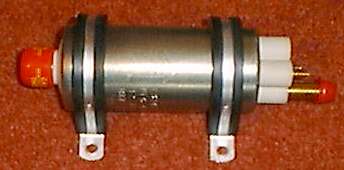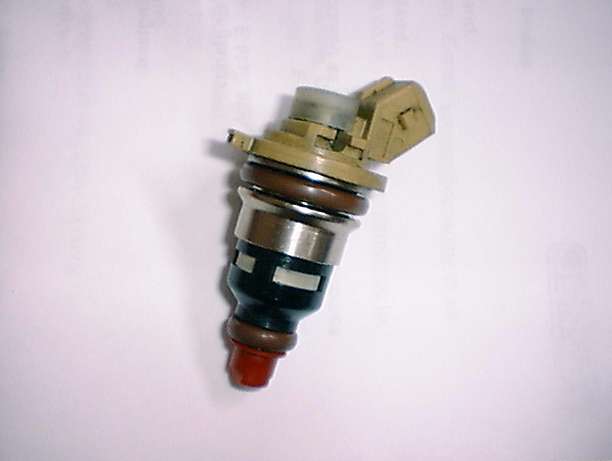Fuel Injection - Page 3
LastHow does an injector work?
An injector has a high pressure fuel feed at the top (typically), and an outlet at the bottom. Inside the body of the injector, a small electromagnetic coil operates on a steel diaphragm. When the coil is energised, the diaphragm lifts, and allows fuel to pass through the body, and out of the bottom of the injector, as a fine spray. When the coil is de-energised, the diaphragm releases, and the fuel pressure acting on the diaphragm, closes the seal, and fuel is prevented from travelling through the injector body. This can be heard in operation as a faint ticking sound, coming from the injectors on your car.Injectors are switched on and off by the ECU, and are controlled using a technique called Pulse Width Modulation. Ideally, injectors should have a duty cycle of around 80% when maximum power is generated, therefore you want an injector that allows sufficient petrol through at an 80% duty-cycle. As you progressively open the throttle, the ECU measures the throttle opening via the throttle potentiometer, and it adjusts the duty cycle of the injector to richen the mixture as required. The richer the mixture, the longer the duty cycle of the injector, up until the point that it is almost on 100% of the time. Well, this would be the case if the injector were of a smaller capacity than that required by the engine. This is why you need to get the right injectors for your application.
Why not use the Mondeo Zetec injector?
Because they don't physically fit. The picture below shows that the Zetec injector is a side feed, not a top feed, so I can't use them with the throttle bodies, which require top feed injectors.What about the ignition?
The standard Mondeo Zetec engine features an ignition system known as wasted spark. This system comprises of an ignition pack, which has two coils inside. Each coil feeds two spark plugs. The ECU controls the ignition pack and fires alternately between pairs of spark plugs. This is why its called wasted spark. On the top of the exhaust stroke, the spark plug is fired, at the same time that the plug in the cylinder on the compression stroke is also fired, igniting the mixture, and starting combustion. So a spark is wasted, but at what cost?On non-fuel injected engines, you would have a distributor, driven off the camshaft. This device features a rotating arm (rotor arm) which spins round inside the distributor cap, and it directs the high tension electricity supplied by the ignition coil, to each spark plug in turn. Timing is controlled by a weight inside the distributor, and as the distributor spins, the weights move according to the amount of centrifugal force acting on them. This is the advance/retard mechanism. A vacuum pipe from the carburetor also acts upon a diaphragm within the dizzy, which also controls the amount of advance/retard, depending on the amount of throttle. A complicated and crude way to control the ignition timing.
A fuel injected engine (distributorless) requires a method of determining the position of the crank shaft, and the cam shaft. The Zetec flywheel has a series of holes machined around the circumference of the wheel, and a proximity detector sends pulses to the ECU to let it know the crankshaft speed. Another proximity detector on the camshaft sends the position of the cam back (as an angle) to the ECU. From this angle, the ECU can determine the firing order of the engine, and the timing, so it can control the injectors and the ignition pack to fire the spark plugs at precisely the right time for a perfect burn.
What else will I need?
A lot of parts, and if you're fitting the Jenvey & DTA 3D system, you will need to get the following items. Part numbers are in [brackets] along side the description.Fuel pressure regulator
The fuel supply on an injection system, must run at a consistent, regulated pressure. The injectors are precision engineered devices, and can only pass fuel at their calibrated flow rate, if they in turn are supplied with a clean flow of fuel, at a regulated pressure.The fuel arrives at the regulator under high pressure (>3 bar), and unused fuel returns to the fuel tank from the regulator, thus forming a continuous flow of fuel around the system. The pressure regulator sits at the end of the fuel rail, and guarantee's that the pressure in the fuel rail is constant. The regulator varies the fuel pressure proportional to the vacuum applied to the vacuum pipe feed pipe on top of the regulator. When the throttle is depressed, and the vacuum in the inlet manifold reduces, the fuel pressure regulator increases the fuel pressure, to cope with the extra demand from the injectors.
Fuel Pump
Essential for the delivery of a high pressure fuel supply to the fuel injectors, it must be mounted close to the fuel tank on rubber mountings to reduce the noise. It draws fuel from the fuel tank, through the filter, and pushes it on to the fuel rail and regulator.The pump must be protected from debris in the fuel, so the order must be: Fuel Cell, Filter, Pump, Fuel Rail, Regulator, Fuel Cell.





